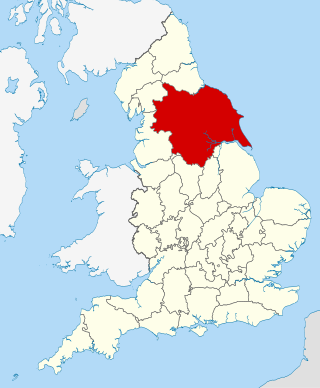In phonetics, rhotic consonants, or "R-like" sounds, are liquid consonants that are traditionally represented orthographically by symbols derived from the Greek letter rho, including ⟨R⟩, ⟨r⟩ in the Latin script and ⟨Р⟩, ⟨p⟩ in the Cyrillic script. They are transcribed in the International Phonetic Alphabet by upper- or lower-case variants of Roman ⟨R⟩, ⟨r⟩: ⟨r⟩, ⟨ɾ⟩, ⟨ɹ⟩, ⟨ɻ⟩, ⟨ʀ⟩, ⟨ʁ⟩, ⟨ɽ⟩, and ⟨ɺ⟩. Transcriptions for vocalic or semivocalic realisations of underlying rhotics include the ⟨ə̯⟩ and ⟨ɐ̯⟩.
Spoken English shows great variation across regions where it is the predominant language. The United Kingdom has a wide variety of accents, and no single "British accent" exists. This article provides an overview of the numerous identifiable variations in pronunciation. Such distinctions usually derive from the phonetic inventory of local dialects, as well as from broader differences in the Standard English of different primary-speaking populations.

Geordie is a nickname for a person from the Tyneside area of North East England and the dialect used by its inhabitants, also known in linguistics as Tyneside English or Newcastle English. There are different definitions of what constitutes a Geordie. The term is used and has been historically used to refer to the people of the North East. A Geordie can also specifically be a native of Tyneside and the surrounding areas. Not everyone from the North East of England identifies as a Geordie.
Pitmatic is a group of traditional Northern English dialects spoken in rural areas of the Northumberland and Durham Coalfield in England.

Scouse, officially known as Liverpool English or Merseyside English, is an accent and dialect of English associated with the city of Liverpool and the surrounding Liverpool City Region. The Scouse accent is highly distinctive as it was influenced heavily by Irish and Welsh immigrants who arrived via the Liverpool docks, as well as Scandinavian sailors who also used the docks, and thus has very little in common with the accents found throughout the rest of England. Natives of Liverpool are officially known as Liverpudlians, but are usually called Scousers; the name comes from scouse, a stew originating from Scandinavian lobscouse eaten by sailors and locals.
Mackem, Makem or Mak'em is a nickname for residents of and people from Sunderland, a city in North East England. It is also a name for the local dialect and accent ; and for a fan, of whatever origin, of Sunderland A.F.C. It has been used by the people of Sunderland to describe themselves since the 1980s, prior to which it was mainly used in Tyneside as a disparaging exonym. An alternative name for a Mackem is a Wearsider.

The Yorkshire dialect is a dialect of English, or continuum of dialects, spoken in the Yorkshire region of Northern England. The dialect has roots in Old English and is influenced by Old Norse. The Yorkshire dialect has faded and faces extinction, but organisations such as The Yorkshire Dialect Society and the East Riding Dialect Society exist to promote its use.

Guttural R is the phenomenon whereby a rhotic consonant is produced in the back of the vocal tract rather than in the front portion thereof and thus as a guttural consonant. Speakers of languages with guttural R typically regard guttural and coronal rhotics to be alternative pronunciations of the same phoneme, despite articulatory differences. Similar consonants are found in other parts of the world, but they often have little to no cultural association or interchangeability with coronal rhotics and are (perhaps) not rhotics at all.

The spoken English language in Northern England has been shaped by the region's history of settlement and migration, and today encompasses a group of related accents and dialects known as Northern England English (or, simply, Northern (English) in the United Kingdom).
This article describes those aspects of the phonological history of the English language which concern consonants.

The Lancashire dialect refers to the Northern English vernacular speech of the English county of Lancashire. The region is notable for its tradition of poetry written in the dialect.

The voiced uvular tap or flap is a type of consonantal sound, used in some spoken languages. There is no dedicated symbol for this sound in the IPA. It can specified by adding a 'short' diacritic to the letter for the uvular plosive, ⟨ɢ̆⟩, but normally it is covered by the unmodified letter for the uvular trill, ⟨ʀ⟩, since the two have never been reported to contrast.
The English language spoken and written in England encompasses a diverse range of accents and dialects. The language forms part of the broader British English, along with other varieties in the United Kingdom. Terms used to refer to the English language spoken and written in England include English English and Anglo-English.

Northumbrian dialect or Northumbrian English is any one of several English language varieties spoken in the traditional English region of Northumbria, which includes most of the North East England government region. The traditional Northumbrian dialect is a moribund older form of the dialect spoken in the area which is closely related to Scots and Cumbrian and shares with them a common origin in Northumbrian Old English.

Mancunian, sometimes shortened to Manc, is the accent and dialect of English spoken in Manchester and some of the wider Greater Manchester area. It is also the name of a native or resident of Manchester. Described as "twangy" and "euphonic", it is sometimes regarded as one of the friendliest accents in the UK.
The distinction between rhoticity and non-rhoticity is one of the most prominent ways in which varieties of the English language are classified. In rhotic accents, the sound of the historical English rhotic consonant,, is preserved in all pronunciation contexts. In non-rhotic accents, speakers no longer pronounce in postvocalic environments: when it is immediately after a vowel and not followed by another vowel. For example, in isolation, a rhotic English speaker pronounces the words hard and butter as /ˈhɑːrd/ and /ˈbʌtər/, but a non-rhotic speaker "drops" or "deletes" the sound and pronounces them as /ˈhɑːd/ and /ˈbʌtə/. When an r is at the end of a word but the next word begins with a vowel, as in the phrase "better apples," most non-rhotic speakers will pronounce the in that position since it is followed by a vowel in this case.
Uvularization or uvularisation is a secondary articulation of consonants or vowels by which the back of the tongue is constricted toward the uvula and upper pharynx during the articulation of a sound with its primary articulation elsewhere.
The pronunciation of the phoneme in the English language has many variations in different dialects.
Northumbria was an Anglo-Saxon kingdom in early medieval England.
On early English pronunciation: with especial reference to Shakspere [sic] and Chaucer, containing an investigation of the correspondence of writing with speech in England from the Anglosaxon [sic] period to the present day means of the ordinary printing types is an 1889 book by Alexander John Ellis. Since publication, it has been cited continuously by dialectologists of English and Scots, owing to its survey data on the dialects in the 19th century. The author is regularly cited by linguists as "A.J. Ellis" to distinguish him from Stanley Ellis, a prominent dialectologist of the 20th century.









